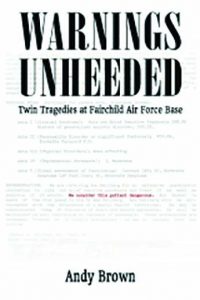Review by | Chris Bird
WARNINGS UNHEEDED: TWIN TRAGEDIES AT FAIRCHILD AIR FORCE BASE, by Andy Brown. ©t 2016. Published by WU Press, Spokane, Wash. List Price $19.99. Trade paperback, available on Amazon.
 In June 1994, Andy Brown was a Security Police officer in his early twenties at Fairchild Air Force Base near Spokane, WA. He was on patrol on a bicycle, armed with a standard issue Beretta 9mm. A recently discharged airman had just killed four people and wounded 22 with an MAK-90 semi-automatic rifle with a 75-round magazine when Brown spotted him. The officer took him down with four shots at about 70 yards.
In June 1994, Andy Brown was a Security Police officer in his early twenties at Fairchild Air Force Base near Spokane, WA. He was on patrol on a bicycle, armed with a standard issue Beretta 9mm. A recently discharged airman had just killed four people and wounded 22 with an MAK-90 semi-automatic rifle with a 75-round magazine when Brown spotted him. The officer took him down with four shots at about 70 yards.
Four days later, a lieutenant-colonel who was piloting a B-52 and practicing for an air show flew the huge bomber into the ground killing himself and three other senior officers aboard.
In both cases the warning signs were there that the killer and the pilot were unstable and were likely a danger to themselves and others. In the case of the airman, Air Force officers who were mental health professionals had recommended he be let go. Some of his colleagues were afraid of him. In the case of the pilot, some officers wanted him grounded and refused to let their crew members fly with him.
Since Airman Dean Mellberg joined the Air Force in June 1992, there had been questions about his mental health. These continued when he was posted to Fairchild. He was examined by Captain Alan London, a psychologist, and by Dr. Thomas Brigham, a psychiatrist who held the rank of major. Mellberg killed both men during his killing spree. Many of his colleagues and even some supervisors expressed fear of the airman. One colleague, a sergeant, predicted that someday Mellberg would come to work with a gun intent on killing.
In an evaluation of the airman, Brigham wrote: “We are referring Airman Mellberg for an extensive psychiatric evaluation to rule out reactive psychosis or treat it as well as possible if it does exist. We consider this patient dangerous.”
In September 1993, the airman was sent from Fairchild to the psychiatric ward of Wilford Hall Medical Center in San Antonio. After several recommendations for discharge had been overruled, Mellberg was finally given an honorable discharge in May of 1994. Less than a month later he took a taxi to Fairchild AFB and began shooting people.
Brown documents Mellberg’s medical history in great detail in the first third of the book. He intersperses it with chapters about Lt. Col. Arthur “Bud” Holland’s history of breaking safety rules in flying the B-52 Stratofortress.
The chapter about the police response to Mellberg’s rampage is particularly interesting. Brown gives a shot-by-shot account of his battle with the killer. He acknowledges being affected by tunnel vision as he concentrated on shooting the threat. He was concerned that his first three shots were having no effect though one had hit Mellberg in the shoulder. It was the fourth shot which hit the killer at the bridge of the nose that ended the fight.
For his actions, Brown was awarded the Airman’s Medal, the highest decoration for heroic actions occurring outside a combat situation.
Four days after the shooting, Holland was flying his B-52, practicing for the annual air show. Three other senior officers were in the plane with him. Partway through the practice, Holland deviated from the script and flew the aircraft into the ground killing all four aboard. The book includes two photographs from the accident investigation. The first shows the B-52 with its wings vertical with a building just below it. The second shows the same building partly obscured by the aircraft hitting the ground.
Brown describes his second battle – the one after the shooting with post-traumatic stress disorder. He beat it with support from his wife. He left the Air Force and now works for the Department of Homeland Security.
In the last chapter, Brown urges ordinary citizens to prepare for mass killing incidents. He cites current law enforcement advice for people to run, hide or fight. He refers to an FBI report, released in 2014 that states most of these incidents last from two to five minutes and “were over before police could intervene.” Many of these 160 incidents studied were terminated by ordinary citizens. Brown urges people who carry concealed handguns to get professional training.
Chris Bird is author of several books including Surviving a Mass Killer Rampage: When Seconds Count, Police Are Still Minutes Away. His website is www.privateerpublications.com



